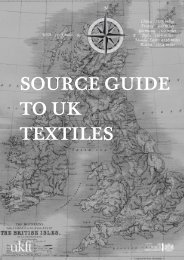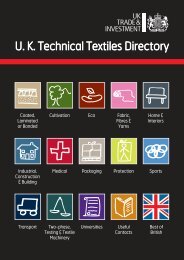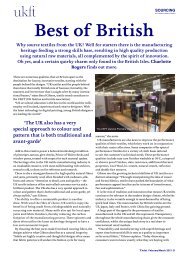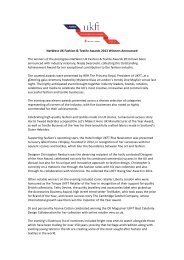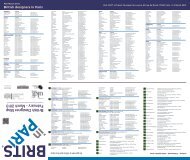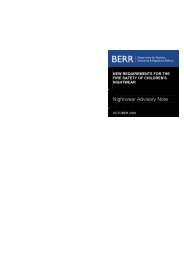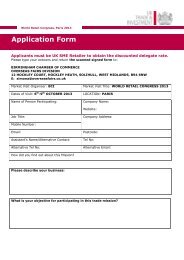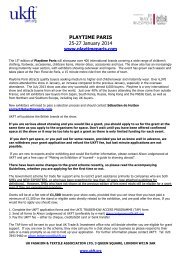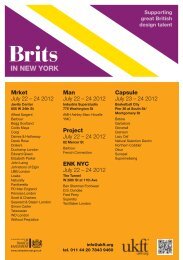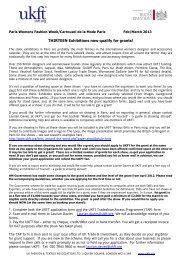NIGHTWEAR AND FIRE - Dius.gov.uk
NIGHTWEAR AND FIRE - Dius.gov.uk
NIGHTWEAR AND FIRE - Dius.gov.uk
Create successful ePaper yourself
Turn your PDF publications into a flip-book with our unique Google optimized e-Paper software.
<strong>NIGHTWEAR</strong> <strong>AND</strong> <strong>FIRE</strong><br />
A Guide to Nightwear (Safety) Regulations<br />
Contents<br />
The Regulations<br />
Labelling Requirements<br />
Requirements For Advertisments<br />
The Test<br />
Enforcement<br />
THE REGULATIONS<br />
Nightwear can burn rapidly, when accidentally set alight by contact with an open<br />
fire or a gas or electric fire or other heat source, and cause serious injury -<br />
children and the elderly being especially vulnerable.<br />
In consequence, various mandatory and voluntary measures have been taken to<br />
control the fire performance of the fabrics used in nightwear and to make the<br />
public more aware of the dangers.<br />
This Guide describes the main features of the Regulations.<br />
• From 1 March 1987, tougher performance requirements regarding<br />
flammability came into force. They are compulsory for children's<br />
nightdresses and dressing gowns.<br />
There are improved safety provisions for the full range of nightwear garments for<br />
babies, children and adults.<br />
Enquiries about the contents of this guide may be made to:<br />
In Great Britain:<br />
Consumer & Competition Policy<br />
Department of Trade and Industry<br />
4th Floor<br />
1 Victoria Street<br />
London SW1H 0ET<br />
Telephone: 020 7215 5576
In Northern Ireland:<br />
The Trading Standards Branch<br />
Department of Economic Development<br />
176 Newtownbreda Road<br />
Belfast BT8 4QS<br />
Telephone: 028 90253900<br />
The safety of daywear clothing (including flammability) is covered by the General<br />
Product Safety Regulations 1994 (SI 1994/No. 2328) which require suppliers of<br />
consumer products to take steps to ensure that their products are safe under<br />
normal or reasonably foreseeable conditions of use. DTI has issued separate<br />
guidance to the General Product Safety Regulations.<br />
1. The Nightwear (Safety) Regulations 1985 i apply to nightwear including<br />
garments which are commonly worn as nightwear. They came into effect<br />
on 1 March 1987 and replaced the Nightdresses (Safety) Regulations 1967<br />
and the Nightdresses (Safety) Regulations (Northern Ireland) 1968.<br />
Suppliers affected by the Regulations<br />
2. The Regulations apply to all persons who supply nightwear and garments<br />
used for a similar purpose in the course of carrying on a business, whether<br />
or not that business is one of dealing in nightwear. Those affected include:<br />
• manufactures<br />
• importers<br />
• wholesalers<br />
• retailers (including mail order traders)<br />
Exemptions<br />
3. The Regulations do not apply to:<br />
• second-hand nightwear<br />
• nightwear intended for export<br />
Main Requirements<br />
4. From 1 March 1987 it has been an offence to 'supply, offer to supply,<br />
agree to supply, expose for supply, or possess for supply' nightwear which<br />
does not meet the new requirements.<br />
5. Children's nightwear: ie garments for children over 3 months and under 13<br />
years of age and not exceeding any of the following maximum<br />
measurements.<br />
• Nightdresses<br />
Chest measurement: 91 cms (approx 36") Length: 122 cms<br />
(approx 48")<br />
• Dressing Gowns, Bath Robes and other similar garments<br />
Chest measurement: 97 cms (approx 38") Sleeve measurement:<br />
69 cms (approx 27")<br />
• Nightdresses, dressing gowns and other similar garments<br />
commonly worn as nightwear must satisfy the flammability
performance requirements specified in Clauses 3.1.1 and 3.2.1 of<br />
British Standard 5722.<br />
• Pyjamas and cotton terry towelling bath robes do not have to<br />
comply with the flammability standard. However, they must carry<br />
a permanent label showing whether or not they meet the<br />
flammability standard.<br />
6. Babies' garments ie garments exclusively for babies under 3 months and<br />
having a chest measurement not exceeding 53 centimetres (approx 21").<br />
• Babies' garments must carry a permanent label showing whether or<br />
not they meet the flammability standard.<br />
7. You should note the following:<br />
• One-piece garments with legs should be treated as children's<br />
pyjamas.<br />
• Stretch garments which can be worn by an infant beyond 3 months<br />
should be treated as children's nightwear. If the garment has legs<br />
it should be treated as pyjamas.<br />
• Garments doubling as sleeping bags and dressing gowns which can<br />
be worn by an infant beyond 3 months should be treated as<br />
children's dressing gowns.<br />
8. Adults' nightwear<br />
• Adults' nightwear and garments commonly worn as nightwear<br />
must carry a permanent label showing whether or not they meet<br />
the flammability standard.<br />
9. Garments commonly worn as nightwear<br />
You should note that the Regulations apply to garments supplied as<br />
nightwear, and garments supplied otherwise than for nightwear, but<br />
which are similar in nature and are commonly worn as nightwear. For<br />
example:<br />
• bath robes<br />
• negligees<br />
• snuggle wraps.<br />
Other requirements<br />
The following requirements also apply to nightwear garments:<br />
10. The flammability performance requirements relate to the whole area of the<br />
garment including all threads, trimmings, decorations, and labels.<br />
However, elastic and elastic thread used for making gathers in material<br />
are exempt from the flammability requirements.<br />
11. Nightwear made of and trimmed with synthetic fabric which melts without<br />
decomposing when ignited as part of the British Standard test can be<br />
taken to meet the flammability performance requirements (see paragraph<br />
5 of page 7).
12. Nightwear which has been treated with flame retardant chemicals must<br />
carry the appropriate warning label about washing and suitability of the<br />
washing agent.<br />
13. Advertisements in newspapers, magazines, catalogues etc which contain<br />
any direct ordering facility for readers must include information about the<br />
flammability performance of the nightwear described.<br />
i The Nightwear (Safety) Regulations 1985<br />
S1 1998/No. 2043.<br />
The Stationary Office £1.35 net.<br />
LABELLING REQUIREMENTS<br />
Flammability performance<br />
1. Nightwear which does not meet the flammability performance<br />
requirements must carry a label with the words:<br />
• 'KEEP AWAY FROM <strong>FIRE</strong>' (in red letters)<br />
2. Nightwear which meets the flammability performance requirements must<br />
carry a label with one of the following forms of words:<br />
• 'LOW FLAMMABILITY TO BS 5722' (in black letters), or<br />
• 'LOW FLAMMABILITY TO BS 5722' (in black letters) and 'KEEP<br />
AWAY FROM <strong>FIRE</strong>' (in red letters), or<br />
• 'KEEP AWAY FROM <strong>FIRE</strong>' (in red letters).<br />
3. All words must be in medium letters of 10 point in upper case.<br />
4. You should note that children's nightdresses and dressing gowns which<br />
must meet the flammability performance requirements do not need to<br />
carry a label. However, suppliers may choose to confirm compliance using<br />
one of the above forms of words.<br />
Washing instructions<br />
5. Any nightwear which is treated with flame retardant chemicals must carry<br />
a label with the words:<br />
'DO NOT WASH AT MORE THAN 50 o C. CHECK SUITABILITY OF<br />
WASHING AGENT (in black letters).<br />
6. The words must be in medium letters of 6 point in upper case.<br />
Nightwear (Safety) Regulations 1985 - Examples of print sizes for<br />
Labelling Requirements<br />
UNIVERS MEDIUM (55) 10pt 2.4 mm<br />
KEEP AWAY FROM <strong>FIRE</strong> (in RED letters)<br />
LOW<br />
FLAMMABILITY<br />
TO BS 5722 (in BLACK letters)<br />
UNIVERS MEDIUM (55) 6 pt 1.8 mm
DO NOT WASH AT MORE THAN 50 o C CHECK SUITABILITY OF WASHING<br />
AGENT (in BLACK letters)<br />
HELVETICA MEDIUM 10pt 2.5 mm<br />
KEEP AWAY FROM <strong>FIRE</strong> (in RED letters)<br />
LOW<br />
FLAMMABILITY<br />
TO BS 5722 (in BLACK letters)<br />
HELVETICA MEDIUM 6pt 1.7 mm<br />
DO NOT WASH AT MORE THAN 50 o C CHECK SUITABILITY OF WASHING<br />
AGENT (in BLACK letters)<br />
Position of the labels<br />
7. Labels showing flammability performance and<br />
washing instructions must be permanent and<br />
securely sewn into the garment.<br />
8. The words may appear in a variety of positions<br />
providing that the information is not obscured by<br />
any other label or part of the garment. They may<br />
appear on:<br />
• a separate label on the inside of the neck<br />
of the garment; or<br />
• any label giving size details of the<br />
garment, in which case the wording must<br />
appear immediately below that<br />
information; or<br />
• a label immediately beside any other<br />
permanent label giving size details of the<br />
garment.<br />
9. If both flammability performance information and washing instructions are<br />
required and are to appear on the same label the washing instruction<br />
warning must appear immediately below the flammability performance<br />
information.<br />
10. The words must be in durable print and must appear on a label of<br />
sufficient - colour contrast to enable them to be clearly seen.<br />
11. You should note that:<br />
• If a loop label is used we recommend that the flammability<br />
performance information should be given on the front of the label.<br />
• For pyjamas, we recommend that the flammability performance<br />
information and any washing instruction warning should be given<br />
at least on the jacket of the garment.
REQUIREMENTS FOR ADVERTISEMENTS<br />
1. Any advertisement of the kind described in paragraph 13 of page 3 must<br />
include information about the flammability performance of each type of<br />
nightwear featured. It can give this information by using:<br />
• the appropriate specified words as for the flammability performance<br />
labels (see page 4) or<br />
• the appropriate symbol illustrated below.<br />
Symbol (a)<br />
2. The triangle must be equilateral and have red sides not less than 10mm<br />
long.<br />
The phrase 'KEEP AWAY FROM <strong>FIRE</strong>' must be in black letters of at least 2<br />
point in size.<br />
Symbol (b)<br />
3. The rectangle with green sides must not be less than 8mm long by 6mm<br />
wide. The phrase 'LOW FLAM' must be in black letters of at least 4 point in<br />
size.<br />
4. For nightwear which does not meet the flammability performance<br />
requirements Symbol (a) must be used.<br />
5. For nightwear which meets the flammability performance requirements,<br />
one of the following must be used:<br />
• symbol (b) alone, or<br />
• symbol (b) and symbol (a), or<br />
• symbol (a) alone.<br />
6. An advertisement must not, however, contain a combination of both<br />
symbols and words. If the symbols are used, a clear explanation of the<br />
meaning of the symbol must be given within the confines of that<br />
advertisement, or in the case of an advertisement in a catalogue, the<br />
explanation may be given by means of a key appearing elsewhere in the<br />
catalogue
7. Advertisements do not need to contain information about the flammability<br />
performance of children's nightdresses and dressing gowns because they<br />
must meet the flammability performance requirements. However,<br />
suppliers may choose to confirm compliance by using the appropriate<br />
words or symbols.<br />
THE TEST<br />
1. Nightwear is tested to see whether or not it meets the flammability<br />
performance requirements which are specified in clauses 3.1.1 and 3.2.1<br />
of British Standard 5722 i . These requirements are expressed at a rate of<br />
flame spread. The method of test to be used is Test 3 of British Standard<br />
5438 ii . This specifies 6 test pieces of the garment each of 670mm x<br />
170mm (approx 26" x 61/2"). These must include a sample of all threads<br />
trimming and decorations etc which are present on the full garment.<br />
However, elastic and elastic thread used for making gathers should be<br />
removed before testing. BS 5438 provides modified procedures for testing<br />
narrow fabrics and assemblies, including provision, when necessary, for<br />
trimmings to be tested separately.<br />
2. Before testing, test pieces must be washed once in accordance with the<br />
procedure specified in Clause 6.5.2 of British Standard 5651 iii . If the<br />
fabric has been treated with flame retardant chemicals to make it safer<br />
from fire the test pieces must be washed twelve times as specified in<br />
Clause 6.5.2.7 of this British Standard. This is to ensure that the<br />
treatment is sufficiently durable.<br />
3. After drying and conditioning, each test piece is pinned to a vertical frame<br />
and is subjected to a small butane gas flame (equivalent to a match<br />
flame) which is applied to a point 45mm (approx 2") above the bottom<br />
edge of the fabric for a period of 10 seconds.<br />
4. If any test piece burns to a trip thread at 300mm (approx 12") above the<br />
flame point in less than 25 seconds, or to a second trip thread at 600 mm<br />
(approx 24") above the flame point in less than 50 seconds, the test is<br />
failed. In this event a second run of 6 test pieces is allowed. All 6 pieces<br />
must pass the test for the garment to meet the flammability performance<br />
requirements.<br />
5. You should note that:<br />
• Fabrics will react in different ways to the test. Treated cotton or<br />
viscose, for example, may char but not ignite or melt, and may<br />
pass the test.<br />
• Fabrics, such as nylon and polyester, which melt away cleanly from<br />
the flame (ie without decomposing) may pass the test providing<br />
that all threads, trimmings and decorations etc are also of a<br />
synthetic substance which behaves in this way.<br />
i BS 5722:1984 (Flammability performance of fabrics and fabric<br />
assemblies used in sleepwear and dressing gowns).<br />
ii BS 5438:1976 as amended on 30 April 1981 (Methods of test<br />
for flammability of vertically orientated textile fabrics and fabric<br />
assemblies subjected to a small igniting flame).
iii BS 5651 1978 (Cleansing and wetting procedures for use in<br />
the assessment of the effect of cleansing and wetting on the<br />
flammability of textile fabrics and fabric assemblies).<br />
Copies of these Standards can be obtained from:<br />
The British Standards Institution,<br />
Linford Wood, Milton Keynes MK14 6LE.<br />
ENFORCEMENT<br />
1. The Regulations are made under the Consumer Safety Act 1978.<br />
2. This Act makes it an offence to 'supply, offer to supply, agree to supply,<br />
expose for supply or possess for supply' any goods which contravene<br />
safety Regulations. A person who commits an offence under the Act is<br />
liable on summary conviction to imprisonment for a term not exceeding six<br />
months or a fine currently not exceeding £5,000 or both.<br />
3. The Regulations are enforced by the trading standards departments in<br />
Great Britain, and by district council environmental health officers in<br />
Northern Ireland.<br />
4. This guidance has been prepared to help manufacturers, importers, and<br />
others concerned in the supply of nightwear and similarly used garments<br />
understand the new Regulations.<br />
5. It is not an authoritative interpretation of the Regulations.<br />
End



